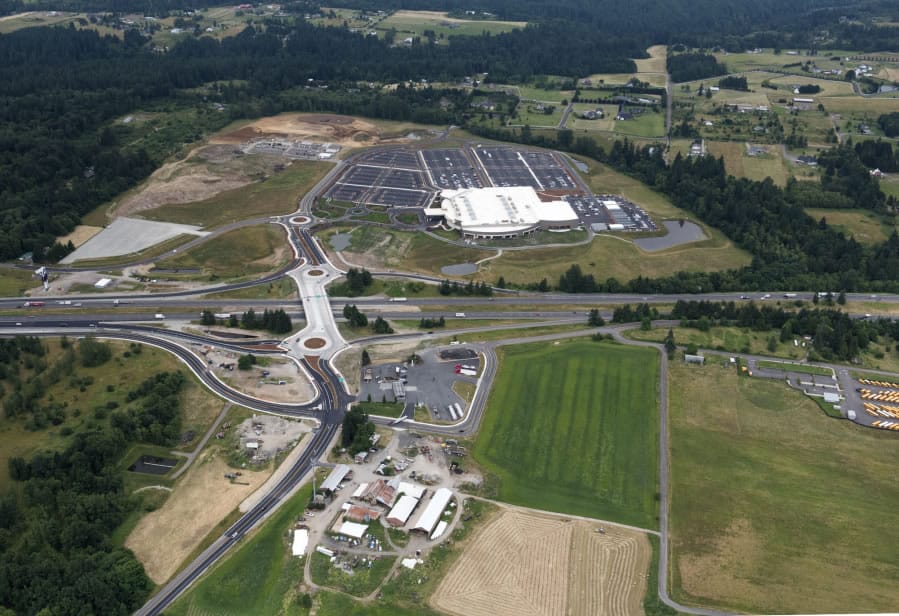LA CENTER — Driving into La Center is pretty straightforward. Take Exit 16 off Interstate 5 and turn east, away from the looming Ilani Casino Resort.
In two miles the road dips into a long left turn toward the East Fork of the Lewis River, the trees draw apart to show the bridge, the city’s wastewater treatment center and the cardrooms next door that helped pay for it.
Greg Thornton, La Center’s mayor, said the distance provides a nice buffer from the freeway, yet it also might be a missed opportunity. There’s very little to signal La Center’s offerings to the increasing number of people traveling to and from the Vancouver-Portland metro area.
But that could change in the coming years.
“Once we get the sewer out here, then this will all be shovel-ready for development,” said Thornton on a recent sunny Friday afternoon.
In July, La Center formally began a yearslong process of developing its western acreage, which butts up against Interstate 5. It first annexed that land in 2011. Developing it could help the city shift its economic base away from one built on houses of cards.
The city’s elevator pitch for economic development touches on a lot of familiar tenets. A 150-acre parcel next to I-5 could be turned into retail, restaurants, green spaces and even apartments. There would be views of Mount Adams and Mount St. Helens.
“Conceptually, it’s a place where people can live and work and really have a lot of amenities,” said Thornton, gesturing to master plans propped up in the city’s public works building, across the street from the cardrooms.
Though plans for the property have been in the works for years, the city made big strides in July.
Crews from Tapani Inc. broke ground on a $5 million project to lay a sewer pipeline to the interchange, allowing future businesses to link into the city service. Two weeks later, the city council voted to set up new zoning rules, and peeled back a year-long moratorium on building permits.
“Now that the moratorium has been lifted, developers, if they are interested in looking at this, can come to the city, talk with our planner and start the process for applications,” the mayor said.
Nobody has applied yet. Thornton is optimistic, though. The land is only hundreds of feet from the 3-month-old casino, which will likely be attractive to plenty of hotels and restaurants looking to fish customers from the stream of gambling enthusiasts.
“I see La Center as being more of a destination for recreation and entertainment,” Thornton said. “We’ve got the Cowlitz casino, and I think that as it continues to develop out, we’ll try to complement that as best we can — take advantage of that as best we can. And try to augment some of the different things we can do.”
Four districts
The newly approved zones outline four districts at the junction: employment, residential and commercial districts and a town center.
The undercurrent of all four districts, though, is a preference for small to medium-sized businesses. Buildings larger than 50,000 square feet or businesses requiring large lots — for example, boat dealers or self-storage units — are either not allowed or require conditional use permits.
“We’re still putting the door open for conditional uses, but really the goal is to avoid a lot of empty lots,” said Eric Eisemann, a land use planner contracted to help the city develop the junction.
Recreation and entertainment will likely be a focus of the commercial district. Eisemann said the plan allows broad use for retail and restaurants, and keeps the door open for cardrooms to site there, as well as marijuana retailers if the city council reverses its stance and decides to allow them.
The employment district could house light industrial manufacturers and office space. The district, at the northern end of the Discovery Corridor, was highlighted by the Columbia River Economic Development Council as a potential hotbed for businesses.
Mike Bomar, president of the public-private partnership, said companies in technology manufacturing, pharmaceutical manufacturing and others could use the site.
“I think a few of the advantages are its proximity to I-5. That’s helpful for moving products up and down the corridor,” Bomar said. “You’re also close enough to an urban environment, and you have the space to manufacture in a light industrial layout. Certainly it’s that combination of logistics and talent attraction that’s going to make that piece (of land) interesting.”
It’s also a few miles from where Clark College is planning to build a campus — Clark College at Boschma Farms — that could contribute to a nearby talent pool, Bomar said.
The East Fork of the Lewis River that bisects La Center will keep a lot of land undevelopable, but Thornton said he hoped to see some outdoor recreation uses at the junction. A park on the south side of La Center Road is planned to give boaters, kayakers and the like better access to the river.
Oscar Maciel said he sees people in La Center more interested in outdoor recreation than ever and thinks the city could leverage its central river. The 47-year-old, his wife and son ran a paddle board rental company in La Center for a year-and-a-half. He said they sold it because they got too busy with their day jobs.
“I definitely see a lot of kayakers out there on the East Fork,” he said. “I think it’s great La Center is developing that park for that reason. It’s great family sport, no matter what craft you’re on.”
Reshuffling
While full development of the 150 acres is in the future, the concept already is a big change for La Center.
The town of 3,200 has long relied on a 10 percent tax on cardrooms, which offer poker, blackjack and other card games, but not slot machines. The city netted about $3.1 million a year, which historically made up 75 percent of the operating budget.
Cardrooms were also the city’s biggest employers. According to a 2013 report from the U.S. Census Bureau, there were 690 full-time jobs in La Center, about 80 percent of which came from education, retail or arts and entertainment. The latter sector, which included the gambling, made up 47 percent of jobs.
Lately, that has not been the case.
Two of the four cardrooms have closed since January 2014 as casinos such as Oregon’s Spirit Mountain, and now Ilani, attracted Portland’s gamblers. The city’s latest financial reports show taxes from cardroom receipts for the first half of the year fell from $1.6 million to $1.1 million this year, a 30 percent drop.
For the months of April and May — Ilani opened April 24 — cardroom revenues fell from $567,965 to $424,756, a 25 percent drop.
“They have diminished more since Ilani opened up,” Thornton said. “It’s too early to tell for sure, but we had, at one time, four cardrooms. And now the city has two cardrooms. It’s hard to imagine that two cardrooms can consistently do what four cardrooms have done in the past. So I do expect that trend to diminish.”
Still, city officials say it’s too early to tell how the city will be impacted. Ilani offers slot-type machines and table games, but doesn’t have a poker room. It sits outside the city limits on the Cowlitz Indian Reservation.
With La Center Junction, the city could capitalize on new properties and renewed interest in the city. A market report from Mackenzie, a Portland-based research firm, is expected to come out in two weeks and detail what kind of investments the city should make to make sure the new area develops as it hopes.




